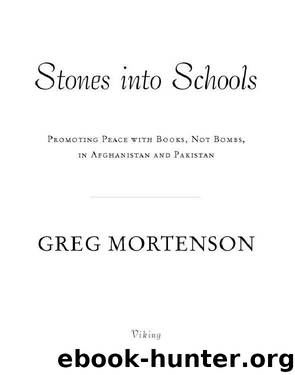Stones into Schools by Greg Mortenson

Author:Greg Mortenson
Language: eng
Format: epub
Publisher: Penguin USA, Inc.
CHAPTER 10
Sarfraz’s Promise
Nobody ever lives their life all the way up except bull-fighters.
—ERNEST HEMINGWAY, The Sun Also Rises
Two sisters in UNHCR earthquake refugee camp, Pakistan
While we continued moving forward with our tent-school projects in the upper Neelum Valley, down in Patika the teachers at the Gundi Piran Girls’ School were dealing with their own set of challenges. On November 1, the school had reopened for business in the tents that Shaukat Ali had requisitioned from the Pakistani army. On the first day of class, only seven girls made an appearance, along with a handful of teachers. One of those teachers was Saima Khan, who continued to show up every day despite the fact that she was still recovering from a severe leg fracture.
Because most of the girls were still in mourning and all of them had lost their textbooks, notebooks, even pencils and pens, Shaukat Ali began the first classes by reading to them from poetry and religious texts. “Reading, literature, and spirituality are good for the soul,” he told them. “So we will start with these studies.”
As the weeks rolled by, word spread that the school had reopened, and girls slowly began trickling back. By the middle of December, there were 145 students—a remarkable number, given that only 195 of them had survived the earthquake.
They spent the winter of 2006 huddled in the tents without electricity or running water, trying to keep warm with blankets and several boxes of clothing donated by a nearby Red Cross compound. Some of the students wore black leather aviator jackets or blue blazers from American businessmen; others wrapped themselves in silk scarves or high-tech Nordic ski gear. One girl in the fifth grade wound up with a bright bubble-gum pink coat that would have done justice to the wardrobe of a Miley Cyrus groupie.
Adding to the physical hardship was a general anxiety over the upcoming exams, which would serve as a prerequisite for entry to the region’s upper-division schools. After the trauma of the earthquake and the many weeks of missed classes, teachers and students alike began to worry that many of the girls might fail. During the evenings, scores of them stayed beyond normal school hours to get caught up.
In March, they held the exams. When the results arrived, it turned out that 82 percent of the girls had passed.
Saida Shabir considered the performance truly remarkable, given the odds that her teachers and students were up against. At the same time, though, the results—which would have been acceptable under normal circumstances—seemed to underscore the enormity of the problems that Gundi Piran continued to confront. Six months after the earthquake, the school still lacked a building, basic services, and teaching supplies—and given the doleful state of reconstruction in Azad Kashmir, it was doubtful that any of these issues would be redressed anytime soon. Despite the progress they had made, the future looked bleak.
What Ms. Shabir had no way of knowing at the time, however, was that help was on its way—although the emissary
Download
This site does not store any files on its server. We only index and link to content provided by other sites. Please contact the content providers to delete copyright contents if any and email us, we'll remove relevant links or contents immediately.
| Arms Control | Diplomacy |
| Security | Trades & Tariffs |
| Treaties | African |
| Asian | Australian & Oceanian |
| Canadian | Caribbean & Latin American |
| European | Middle Eastern |
| Russian & Former Soviet Union |
The Secret History by Donna Tartt(16623)
The Social Justice Warrior Handbook by Lisa De Pasquale(11489)
Thirteen Reasons Why by Jay Asher(7788)
This Is How You Lose Her by Junot Diaz(5772)
Weapons of Math Destruction by Cathy O'Neil(5037)
Zero to One by Peter Thiel(4824)
The Myth of the Strong Leader by Archie Brown(4789)
Promise Me, Dad by Joe Biden(4447)
Beartown by Fredrik Backman(4419)
Stone's Rules by Roger Stone(4415)
How Democracies Die by Steven Levitsky & Daniel Ziblatt(4399)
The Fire Next Time by James Baldwin(4343)
100 Deadly Skills by Clint Emerson(4079)
A Higher Loyalty: Truth, Lies, and Leadership by James Comey(4033)
Rise and Kill First by Ronen Bergman(4012)
The David Icke Guide to the Global Conspiracy (and how to end it) by David Icke(3882)
The Farm by Tom Rob Smith(3872)
Secrecy World by Jake Bernstein(3782)
The Doomsday Machine by Daniel Ellsberg(3731)
